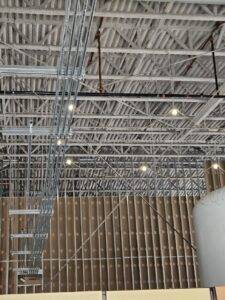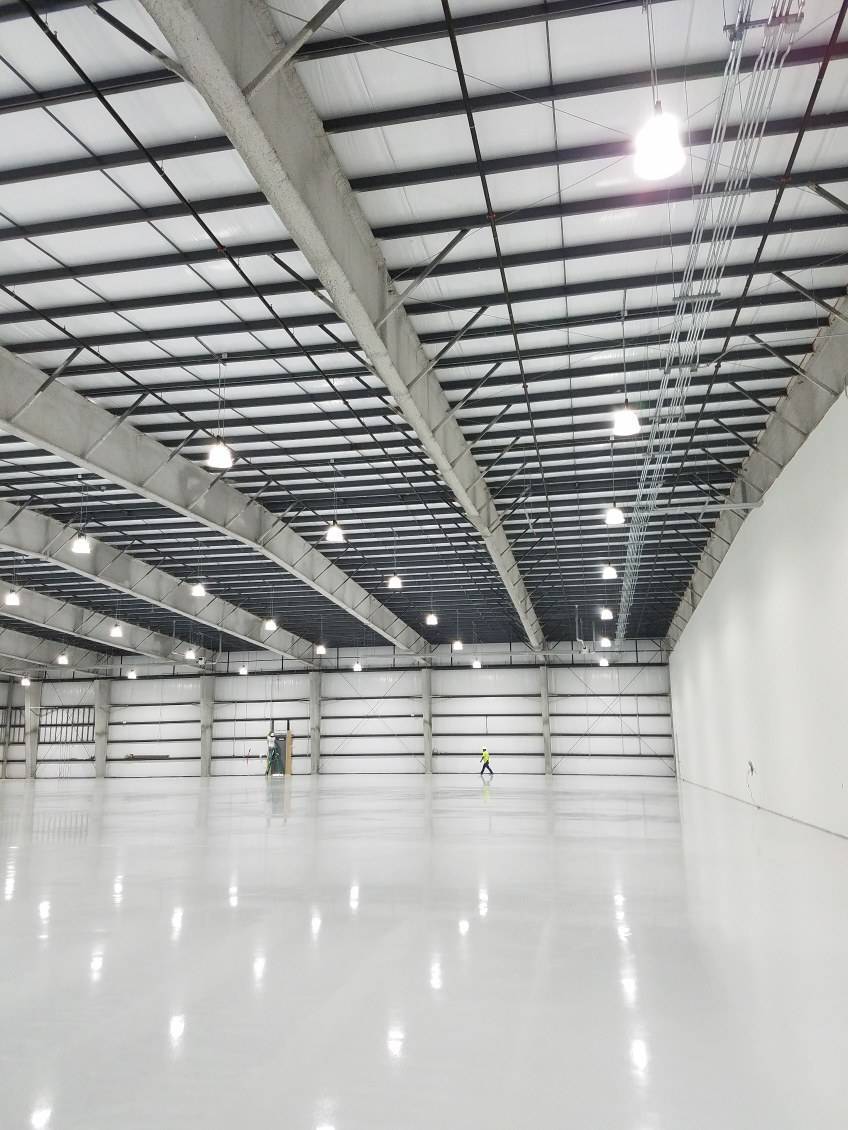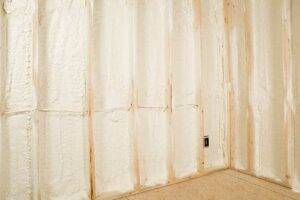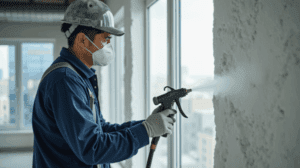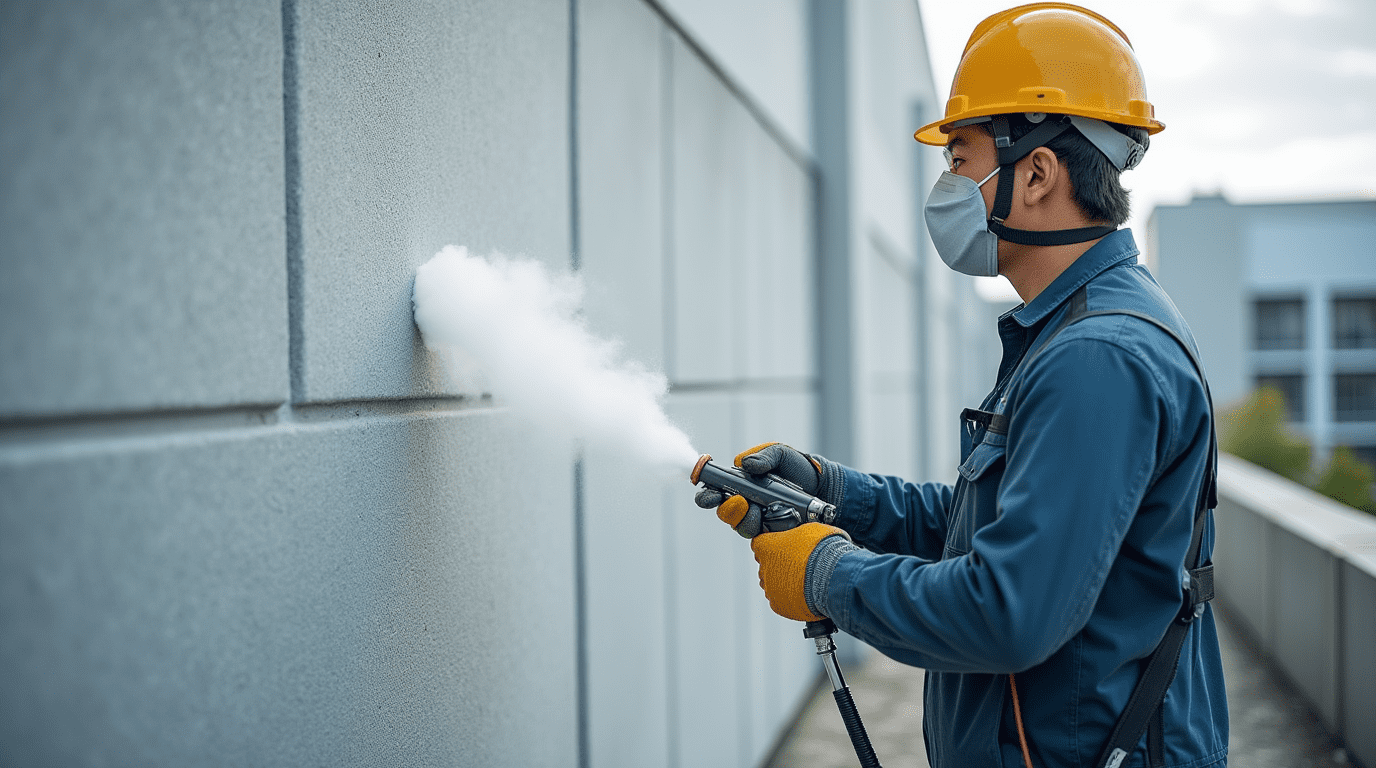Professional K-13 Application Methods for Commercial Projects
Bahl Fireproofing
Installing spray-applied cellulose insulation isn’t like rolling out fiberglass batts or stacking foam boards. K-13 spray fiber insulation requires specialized equipment, trained applicators, and precise technique to deliver the thermal and acoustic performance that commercial facilities depend on. Understanding proper application methods helps facility managers, architects, and contractors ensure their projects meet code requirements and perform as specified for decades.
TLDR: K-13 spray fiber insulation must be installed by licensed, ICC-certified contractors using specialized equipment and techniques. Proper surface preparation, environmental conditions (substrate temperatures above 40-50°F), and quality control during application are critical for achieving the material’s rated performance. The installation process involves calibrated mixing of recycled cellulose fibers with water-based adhesive binder, spray application at 3 to 4 feet distance, and verification through density testing and thickness measurements. When properly applied to clean, dry substrates, K-13 provides 75 years of maintenance-free thermal and acoustic performance in a single application.
Why Application Technique Matters
I’ve seen plenty of insulation projects where the material itself was specified correctly, but poor installation compromised performance from day one. A facility manager selects K-13 for its combined thermal and acoustic benefits, the architect details it properly, and then an unqualified contractor applies it incorrectly. The result: inadequate coverage, inconsistent density, poor adhesion, or thickness variations that reduce both R-value and sound absorption.
K-13 spray-applied insulation delivers R-3.7 per inch thermal resistance and NRC ratings up to 1.05 when installed correctly. However, these performance metrics depend entirely on proper application technique. Inadequate surface preparation leads to adhesion failures. Incorrect fiber-to-adhesive ratios affect density and thermal performance. Insufficient thickness in corners or near penetrations creates thermal bridges and acoustic weak points.
The difference between excellent K-13 performance and disappointing results usually comes down to three factors: applicator training and certification, surface preparation, and quality control during installation. Understanding these factors helps you specify installation requirements clearly and verify that contractors follow proper procedures.
Licensed Applicator Requirement: Why It’s Not Negotiable
K-13 must be installed by ICC-licensed contractors who have completed manufacturer training on mixing parameters, spray techniques, and quality verification procedures. This isn’t a suggestion. It’s a requirement that affects warranty coverage, code compliance, and long-term performance.
The licensing requirement exists because K-13 application involves variables that untrained contractors can’t control effectively: fiber-to-adhesive ratio, spray distance and angle, environmental condition adjustments, and substrate preparation requirements. Manufacturer training covers equipment calibration, spray patterns for different geometries, density verification, and troubleshooting common challenges, ensuring consistent results across different projects and building conditions.
Essential Equipment for Professional K-13 Application
K-13 requires specialized equipment: ICC-approved fiber machines with airlock systems, specialized spray nozzles (2 to 3 inches diameter) that control fiber-to-binder ratios, water pump systems capable of 200 to 300 PSI, and semi-spiral hoses (2.5 to 3 inches diameter) that tumble material during transport.
The fiber machine’s airlock system maintains consistent material flow while preventing backpressure that could affect density. The spray nozzle ensures proper mixing of cellulose fibers with water-based adhesive binder at the point of application. Properly calibrated equipment delivers consistent density throughout installation. Semi-spiral hoses tumble the fiber-adhesive mixture during transport, maintaining uniform consistency that standard smooth-bore hoses cannot achieve.
Critical Surface Preparation Steps
Surface preparation determines whether K-13 adheres properly and maintains adhesion for its 75-year service life. The substrate must be clean, dry, and free from contaminants that prevent bonding. According to ASTM testing standards, proper surface preparation is critical for achieving rated performance in spray-applied insulation systems.
Visual inspection identifies substrate conditions before application begins. Metal decking (the most common commercial substrate for K-13) must be free from oil, grease, rust scale, and dust. Concrete surfaces require removal of form release agents, curing compounds, or previous coatings that interfere with adhesion. Wood substrates need inspection for moisture content and surface contamination.
Cleaning methods vary by substrate and contamination type. Light dust typically requires blowing or vacuuming. Oil or grease contamination may need solvent cleaning or detergent washing followed by thorough rinsing. Some substrates require primers to ensure proper adhesion, particularly previously painted surfaces or certain metal deck coatings. The manufacturer determines primer requirements based on substrate testing.
Substrate temperature affects adhesion and curing. Minimum substrate temperature typically ranges from 40 to 50°F, though optimal application occurs between 60 and 80°F. Cold metal decking in winter presents challenges, as the material may not cure properly or could experience adhesion issues. Monitoring substrate temperature and delaying application when conditions fall outside acceptable ranges prevents future problems.
Masking and protection of areas not receiving insulation must happen before application begins. Overspray removal from windows, skylights, mechanical equipment, or architectural features requires time and labor. Proper masking prevents this issue. Additionally, all hangers, sleeves, electrical boxes, and roof penetrations should be installed before K-13 application. Installing these items afterward requires cutting through the insulation, creating gaps and thermal bridges.
The Application Process: Step by Step
Material mixing begins with calibrated equipment controlling the fiber-to-adhesive ratio precisely. Cellulose fibers enter through the airlock mechanism, mix with water-based adhesive binder, travel through the semi-spiral hose, and receive final mixing at the spray nozzle immediately before application.
Spray distance typically ranges from 3 to 4 feet from the substrate, adjusted based on ceiling height and accessibility. Maintaining consistent distance ensures uniform density and coverage. Spray angle varies by location: main ceiling coverage uses 5 to 10 degree downward angle, while top plates and corners often require 45-degree angles for adequate coverage.
Multiple passes build specified thickness gradually rather than attempting full depth in a single application, ensuring proper adhesion at each layer and preventing sagging in thicker installations. The material exhibits natural texture variation. Uniform coverage requires consistent nozzle movement and overlap patterns, with particular attention to corners, edges, and transitions around penetrations where thin spots create thermal bridges or acoustic weak points.
Thickness and Density: Meeting Performance Specifications
K-13 can be applied from three-quarters of an inch to 5 inches thickness without mechanical supports. Applications requiring greater thickness (up to 10 inches) need mechanical supports or netting. Most commercial applications fall in the 1.5 to 3 inch range, providing R-5.6 to R-11.1 thermal resistance.
Nominal density for K-13 is 3.5 pounds per cubic foot. Achieving this density throughout application determines whether installed material meets specified thermal and acoustic performance. Density verification happens through core sample testing during and after application, with contractors extracting cylindrical samples from representative areas to calculate installed density.
Thickness measurements verify that installed depth meets specifications. According to Energy.gov’s insulation guidance, proper thickness is critical for achieving rated R-values. ASTM E-605 provides field procedures for measuring thickness, with spot checks throughout application identifying areas needing additional material before project completion.
Environmental Conditions and Timing Considerations
Temperature affects every aspect of K-13 application. Substrate temperatures must remain within the 40 to 80°F range for proper application and curing. Cold substrates slow curing and potentially affect adhesion. Freezing temperatures can damage the liquid adhesive binder. Hot substrates accelerate curing, sometimes too rapidly for proper bonding.
Ventilation during and after application affects curing time. The water-based adhesive binder cures through evaporation, requiring adequate natural or mechanical ventilation to remove moisture. Humidity influences curing rates and spray characteristics. High humidity slows evaporation, while very low humidity can cause rapid surface drying affecting bonding.
Project coordination timing matters significantly. K-13 should be installed after structural elements, hangers, sleeves, and roof penetrations are complete but before ductwork, piping, or finish trades begin. This sequence prevents damage and avoids extensive protection or repair work.
Common Substrates and Special Considerations
Metal decking represents the most common substrate for commercial K-13 applications, with the material adhering well to clean metal surfaces. Ribbed configurations require attention to coverage in ribs and valleys for uniform thickness.
Concrete and concrete T-deck applications need particular attention to surface preparation. Form release agents and curing compounds must be completely removed. Some surfaces require priming for long-term bonding. Wood framing and plywood substrates generally accept K-13 well, though moisture content must be verified before application.
Gypsum board applications occur primarily in wall assemblies where K-13 provides thermal and acoustic performance before finish surfaces. Barrel-vault configurations and complex ceiling geometries benefit from K-13’s spray-applied nature, conforming to irregular surfaces that would be difficult to insulate with batt or board products.
Quality Control and Verification Procedures
Visual inspection during application identifies coverage issues before they become permanent. The contractor should continuously assess uniformity, checking for thin spots, gaps around penetrations, or visible substrate. Addressing these issues during application costs far less than post-completion repairs.
Density testing through core samples provides objective verification. Multiple samples across different zones ensure consistent density throughout. Thickness measurements at regular intervals verify specified depths are achieved. For projects throughout our service areas in Texas, Kansas, and Oklahoma, proper documentation ensures smooth inspections and project closeout.
Adhesion testing through simple pull tests verifies proper bonding. Well-bonded K-13 should resist removal without tearing or delaminating. Poor adhesion indicates surface preparation problems, environmental issues, or equipment problems. Color consistency provides visual indication of proper mixing, with K-13 exhibiting characteristic gray-white color when properly applied.
Health, Safety, and Code Compliance
Worker safety during K-13 application requires appropriate personal protective equipment: respiratory protection, eye protection, and gloves. Fall protection systems are essential for elevated work. OSHA compliance for dust exposure applies, with proper ventilation reducing airborne cellulose fiber concentrations.
Code compliance involves multiple standards: ASTM C739 for cellulose insulation, ASTM E84 Class A ratings (Flame Spread 5, Smoke Developed 5), International Building Code requirements, and UL approvals. Local jurisdiction approvals, including Miami-Dade and LA County, address region-specific requirements.
GREENGUARD Gold certification verifies low VOC emissions, supporting LEED v4 indoor air quality requirements. The material’s 80 percent pre-consumer recycled content contributes to LEED materials credits, helping commercial projects meet green building standards.
Maintenance, Protection, and Repair
K-13 requires no maintenance once properly cured and installed, maintaining its thermal and acoustic performance for its 75-year service life without settling or degradation. Protection during construction matters for projects where finish trades work below or around the installation. The material is durable enough for exposed applications but can be damaged by impacts or abrasion.
Repairs to damaged areas involve cleaning the section, removing loose material, and spray-applying new material to match surrounding thickness and density. The water-based adhesive allows new material to bond with existing K-13, creating seamless repairs. Building owners should include insulation inspection in maintenance protocols when roof repairs or modifications affect the ceiling or roof deck above the K-13 installation.
When to Involve Professional K-13 Applicators
Complex projects benefit from early involvement of certified K-13 contractors during design and planning. Contractor input on substrate conditions, access requirements, and installation sequencing prevents construction surprises. According to IRS Section 179D guidance, properly documented insulation installations meeting energy efficiency thresholds can qualify for federal tax deductions. Working with knowledgeable contractors ensures necessary documentation and performance verification.
Projects requiring mock-ups or sample installations allow owners and design teams to evaluate appearance and performance before full installation. International Cellulose Corporation provides technical support for these demonstrations, helping facility managers understand expectations for final quality.
Key Takeaways
Professional K-13 application requires ICC-licensed contractors with manufacturer training on equipment operation, mixing parameters, spray techniques, and quality verification. The investment in qualified contractors pays off through proper installation that delivers rated thermal and acoustic performance for 75 years without maintenance.
Surface preparation determines adhesion and long-term performance. Clean, dry substrates free from contaminants provide the foundation for successful K-13 installation. Substrate temperature must remain within manufacturer specifications (typically 40 to 50°F minimum), and proper ventilation supports curing. Skipping or shortcutting preparation steps creates problems that surface only after construction is complete.
Quality control during installation through density testing, thickness verification, and visual inspection ensures that installed material meets specifications. Core sample testing provides objective evidence of proper density. Thickness measurements verify adequate coverage. Continuous visual monitoring catches problems while they can still be corrected easily.
K-13’s unique combination of thermal insulation (R-3.7 per inch), acoustic absorption (NRC up to 1.05), fire-rated finish (ASTM E84 Class A), and maintenance-free 75-year lifespan makes proper installation critical. The material’s performance depends entirely on correct application technique. Choosing certified, experienced contractors and verifying that they follow proper procedures protects your investment and ensures the building performs as designed.
If your commercial project requires spray-applied insulation that delivers both thermal and acoustic performance with a fire-rated finish, proper installation matters as much as material selection. Contact Bahl Fireproofing today to discuss your project requirements with certified K-13 applicators who understand professional application techniques and quality control procedures. We’ll ensure your installation meets specifications, passes inspections, and performs for the life of your building.
Disclaimer: This article provides general educational information about fireproofing and insulation systems and does not constitute professional engineering advice or product specification. System selection must be based on project-specific fire ratings, thermal requirements, acoustic performance needs, environmental conditions, substrate requirements, and budget constraints. Code requirements vary by jurisdiction and project type. Always consult with a licensed professional and verify UL or FM assembly listings before finalizing specifications.

